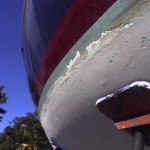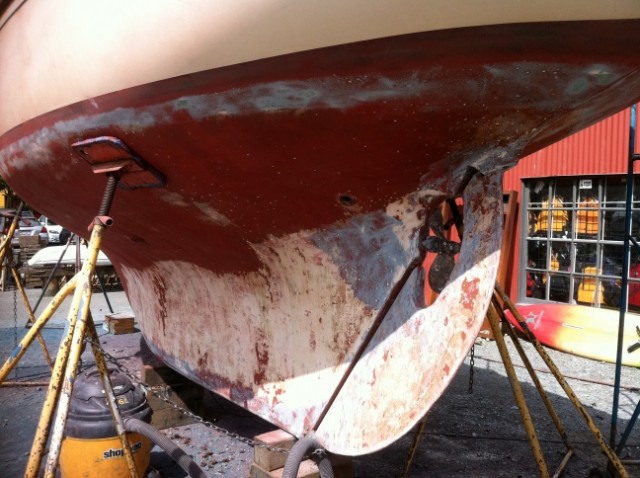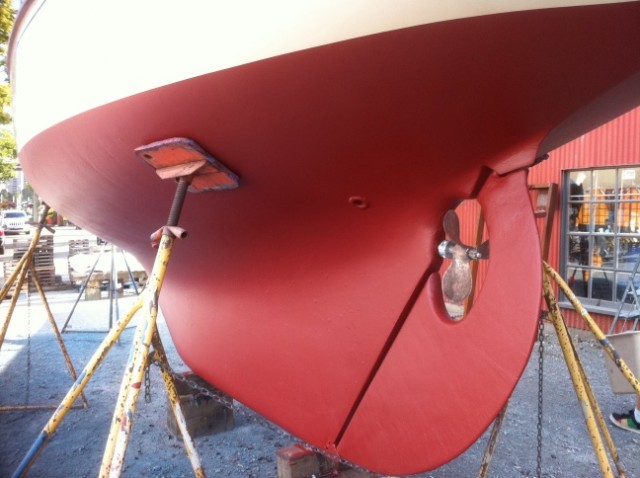Antifouling
We all hate it, but it needs to be done, so it ought to be done right. All too often boats are painted with too little thought and preparation – even by professionals – and the result is a paint job that performs poorly and needs to be redone or removed in short order.
Biocide-based antifouling paints all share a few characteristics that should be remembered when looking at bottom paint options. One is that they are active coatings, and as much as half of the mass of the paint is a biocide (usually in the form of cuprous oxide) that will leach out over time into the ocean — that’s how they prevent growth. This means that there is some of the paint left on the boat, even in the case of “soft” paints that slough off. How much of the film is left on the hull depends on the type of paint, application methods and conditions, age of the paint, and the boat’s usage patterns. Sometimes the leftover films can get very rough and broken down.
Another aspect is that there are a variety of ways that the paints release the poison. The main ones are sloughing, contact leaching, and solubility. Sloughing, or traditional “soft” paints (like Interlux Bottomkote XXX and Pettit Horizons) wear away with the action of water against the hull. Much of their effectiveness and longevity depends on using the boat — if it sits for long periods of time the paint doesn’t wear away and gets fouled, which compromises its ability to wear away evenly in the future. These paints don’t leave as much of a film behind, but they do leave some, and what they leave tends to become quite rough over time because of uneven wear.
Contact leaching paints (like Interlux Fiberglass Bottomkote or Pettit Premium Performance) are porous, and release biocide through the film itself. Once the biocide is gone, the leftover paint is no longer effective at all. They don’t get as rough as the traditional soft paints, but they do leave a thicker buildup over time. These are generally single-season paints; their advantages are that they’re cheaper, they’re hard and can be cleaned in the water, and the drying times are short, so your haulout is quicker.
Controlled solubility paints (like Micron CSC), on the other hand, have some of the benefits of both “hard” and “soft” paints in that they stay smooth, but they don’t leave much of a film behind. The difference is that they don’t rely on the boat’s motion to wear away; they dissolve slowly on their own over time.
It’s important to note that all these bottom paints continue to break down even when more paint is applied. There comes a point in the life of any bottom paint system when it’s unproductive to put new paint on, since the older layers of paint are breaking down and no longer adhering to the substrate, or each other. Much can be done to delay this unhappy state if the old paint is sanded before new paint is applied, but even if the best paints are used and great care is taken, there will come a time when all the remaining bottom paint needs to be stripped off and a new coating applied.

Many layers of old paint, showing the breakdown of adhesion of the oldest layers to the gelcoat underneath.
A third characteristic of bottom paints is that because they leech biocide out over time, the longevity of one paint job is directly proportional to the amount of paint applied. With traditional hard paints there’s a limited benefit of applying more coats, since the outside coats will tend to trap in the biocide of the inside coats, but with ablative or controlled-solubility paints you can easily get two or three seasons or even more with three or four coats. It’s also worth noting that not all coats of paint are equal — while some people paint very thin coats, we pride ourselves on following the manufacturers’ recommendations, and being generous with bottom paint. We regularly use one-and-a-half times as much paint per coat as some of our competitors. If you’ve had your boat painted, it’s worth asking how many gallons were used rather than how many coats were applied, since you can compare this with the manufacturer’s coverage suggestions.
Last but not least are the environmental considerations. Soft paints are the hardest on the ocean, since the whole toxic paint film ends up in the water. Paints with less cuprous oxide in them are gentler, although they may not be as effective. Paints that cure to a hard film, like the contact leaching or controlled-solubility paints, can be cleaned in the water without releasing the dreaded “deleterious substance,” which is what happens when divers scrub soft paints. (This also shortens the life of the paint job, since some of the paint is removed.) Of course, if you have toxic paint on your boat, the best thing to do for the environment is to get as much life out of the paint job as possible, and we find that customers with hard paints can often get another season before repainting with one or two well-timed cleanings by the dive team.
Because of their toxicity, all biocide-based antifouling paints will almost certainly be banned eventually (it’s already happening in San Diego and Washington state), which is why we’re actively experimenting with biocide-free ways to keep boat bottoms clean. If you’re interested in becoming part of this experiment, please let us know!

A combination of bad prep and bad timing; the epoxy barrier coat is too thin to prevent blistering or help with adhesion, and the boat went too long without being repainted, so the mussels and barnacles had completely broken down the paint in some areas.

